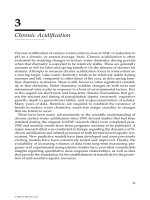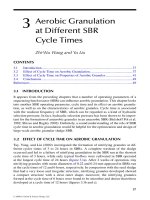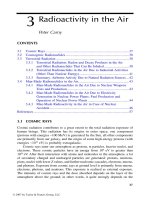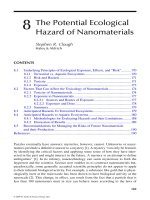Accessing the WAN – Chapter 3 potx
Bạn đang xem bản rút gọn của tài liệu. Xem và tải ngay bản đầy đủ của tài liệu tại đây (2.23 MB, 46 trang )
© 2006 Cisco Systems, Inc. All rights reserved. Cisco Public ITE I Chapter 6
1
Frame Relay
Accessing the WAN – Chapter 3
Cisco Thai Nguyen Networking Academy
© 2006 Cisco Systems, Inc. All rights reserved. Cisco Public ITE 1 Chapter 6
2
Objectives
In this chapter, you will learn to:
– Describe the fundamental concepts of Frame Relay
technology in terms of enterprise WAN services, including
operation, implementation requirements, maps, and Local
Management Interface (LMI) operation.
– Configure a basic Frame Relay permanent virtual circuit
(PVC), including configuring and troubleshooting Frame
Relay on a router serial interface and configuring a static
Frame Relay map.
– Describe advanced concepts of Frame Relay technology in
terms of enterprise WAN services, including subinterfaces,
bandwidth, and flow control.
– Configure an advanced Frame Relay PVC, including solving
reachability issues, configuring subinterfaces, and verifying
and troubleshooting a Frame Relay configuration.
Cisco Thai Nguyen Networking Academy
© 2006 Cisco Systems, Inc. All rights reserved. Cisco Public ITE 1 Chapter 6
3
Frame Relay: An Efficient and Flexible WAN Technology
Frame Relay has become the most widely used
WAN technology in the world.
–Large enterprises, ISPs, and small businesses use
Frame Relay, because of its price and flexibility.
Case study: Example of a large enterprise network.
–Chicago to New York requires a speed of 256 kb/s.
–Three other sites need a maximum speed of 48 kb/s
connecting to the Chicago headquarters,
–The connection between the New York and Dallas
branch offices requires only 12 kb/s.
Using leased lines,
–The Chicago and New York sites each use a
dedicated T1 line (equivalent to 24 DS0 channels) to
connect to the switch, while other sites use ISDN
connections (56 kb/s).
–Because the Dallas site connects with both New York
and Chicago, it has two locally leased lines.
–These lines are truly dedicated in that the network
provider reserves that line for Span's own use.
Cisco Thai Nguyen Networking Academy
© 2006 Cisco Systems, Inc. All rights reserved. Cisco Public ITE 1 Chapter 6
4
Frame Relay: An Efficient and Flexible WAN Technology
Using leased lines,
–You notice a lack of efficiency:
•Of the 24 DSO channels available in the T1
connection, the Chicago site only uses seven.
–Some carriers offer fractional T1 connections in
increments of 64 kb/s, but this requires a specialized
multiplexer at the customer end to channelize the signals.
•In this case, Span has opted for the full T1 service.
•The New York site only uses five of its 24 DSOs.
•Dallas needs to connect to Chicago and New York,
there are two lines through the CO to each site.
Span's Frame Relay network uses permanent
virtual circuits (PVCs). A PVC is the logical path
along an originating Frame Relay link, through
the network, and along a terminating Frame
Relay link to its ultimate destination.
–[Tony]: They are really talking about CIR here.
–It provides both cost effectiveness and flexibility.
Cisco Thai Nguyen Networking Academy
© 2006 Cisco Systems, Inc. All rights reserved. Cisco Public ITE 1 Chapter 6
5
Frame Relay: An Efficient and Flexible WAN Technology
Cost Effectiveness of Frame Relay
–Frame Relay is a more cost-effective option.
•First, with Frame Relay, customers only pay for
the local loop, and for the bandwidth they purchase
from the network provider.
–Distance between nodes is not important.
–with dedicated lines, customers pay for an end-to-
end connection. That includes the local loop and the
network link.
•The second reason for Frame Relay's cost
effectiveness is that it shares bandwidth across a
larger base of customers. Typically, a network
provider can service 40 or more 56 kb/s customers
over one T1 circuit.
The table shows a cost comparison for
comparable ISDN and Frame Relay.
–The initial costs for Frame Relay are higher
than ISDN, the monthly cost is lower.
–Frame Relay is easier to manage than ISDN.
–With Frame Relay, there are no hourly charges.
Cisco Thai Nguyen Networking Academy
© 2006 Cisco Systems, Inc. All rights reserved. Cisco Public ITE 1 Chapter 6
6
The Frame Relay WAN
When you build a WAN, there is always 3 components,
–DTE
–DCE
–The component sits in the middle, joining the 2 access
points.
In the late 1970s and into the early 1990s, the WAN
technology typically using the X.25 protocol.
–Now considered a legacy protocol,
–X.25 provided a reliable connection over unreliable cabling
infrastructures.
–It including additional error control and flow control.
Frame Relay has lower overhead than X.25 because it
has fewer capabilities.
–Modern WAN facilities offer more reliable services.
–Frame Relay does not provide error correction,
–Frame Relay node simply drops packets without
notification when it detects errors.
–Any necessary error correction, such as retransmission of
data, is left to the endpoints.
–Frame Relay handles transmission errors through a
standard Cyclic Redundancy Check.
X.25: Every node of the
network performs extensive
error control and, if
necessary, transmissions
are retried several times.
The end-nodes are also
checking each packet
thoroughly and sequencing
them in the order in which
they were transmitted. This
is known as end-to-end
error control.
Cisco Thai Nguyen Networking Academy
© 2006 Cisco Systems, Inc. All rights reserved. Cisco Public ITE 1 Chapter 6
7
Frame Relay Operation
The connection between a DTE device and a
DCE device consists of both a physical layer
component and a link layer component:
–The physical component defines the mechanical,
electrical, functional between the devices.
–The link layer component defines the protocol
that establishes the connection between the DTE
device (router), and the DCE device (switch).
When use Frame Relay to interconnect LANs
–A router on each LAN is the DTE.
–A serial connection, such as a T1/E1 leased line,
connects the router to the Frame Relay switch of
the carrier at the nearest POP for the carrier.
–The Frame Relay switch is a DCE device.
–Network switches move frames from one DTE
across the network and deliver frames to other
DTEs by way of DCEs.
Cisco Thai Nguyen Networking Academy
© 2006 Cisco Systems, Inc. All rights reserved. Cisco Public ITE 1 Chapter 6
8
Virtual Circuits
The connection through a Frame Relay network
between two DTEs is called a virtual circuit (VC).
–The circuits are virtual because there is no direct
electrical connection from end to end.
–With VCs, any single site can communicate with any
other single site without using multiple dedicated
physical lines.
There are two ways to establish VCs:
–Switched virtual circuits (SVCs): are established
dynamically by sending signaling messages to the
network (CALL SETUP, DATA TRANSFER, IDLE, CALL
TERMINATION).
–Permanent virtual circuits (PVCs): are preconfigured
by the carrier, and after they are set up, only operate in
DATA TRANSFER and IDLE modes.
VCs are identified by DLCIs.
–DLCI values typically are assigned by the Frame Relay
service provider.
–Frame Relay DLCIs have local significance, which
means that the values themselves are not unique in the
Frame Relay WAN.
–A DLCI identifies a VC to the equipment at an endpoint.
A DLCI has no significance beyond the single link.
Cisco Thai Nguyen Networking Academy
© 2006 Cisco Systems, Inc. All rights reserved. Cisco Public ITE 1 Chapter 6
9
Virtual Circuits
The Frame Relay service provider assigns DLCI
numbers. Usually, DLCIs 0 to 15 and 1008 to
1023 are reserved for special purposes.
Therefore, service providers typically assign
DLCIs in the range of 16 to 1007.
In the figure, there is a VC between the sending
and receiving nodes.
–The VC follows the path A, B, C, and D.
–Frame Relay creates a VC by storing input-port to
output-port mapping in the memory of each switch
–As the frame moves across the network, Frame
Relay labels each VC with a DLCI.
–The DLCI is stored in the address field of every
frame transmitted to tell the network how the frame
should be routed.
–The frame uses DLCI 102. It leaves the router (R1)
using Port 0 and VC 102.
–At switch A, the frame exits Port 1 using VC 432.
–This process of VC-port mapping continues through
the WAN until the frame reaches its destination at
DLCI 201.
Cisco Thai Nguyen Networking Academy
© 2006 Cisco Systems, Inc. All rights reserved. Cisco Public ITE 1 Chapter 6
10
Multiple Virtual Circuits
Frame Relay is statistically multiplexed, meaning
that it transmits only one frame at a time, but that
many logical connections can co-exist on a single
physical line.
–Multiple VCs on a single physical line are
distinguished because each VC has its own DLCI.
–This capability often reduces the equipment and
network complexity required to connect multiple
devices, making it a very cost-effective replacement for
a mesh of access lines.
–More savings arise as the capacity of the access
line is based on the average bandwidth
requirement of the VCs, rather than on the
maximum bandwidth requirement.
For example, Span Engineering has five locations,
with its headquarters in Chicago.
–Chicago is connected to the network using five VCs
and each VC is given a DLCI.
Cisco Thai Nguyen Networking Academy
© 2006 Cisco Systems, Inc. All rights reserved. Cisco Public ITE 1 Chapter 6
11
Cost Benefits of Multiple VCs
More savings arise as the capacity of the access line
is based on the average bandwidth requirement of
the VCs, rather than on the maximum bandwidth
requirement.
More of this from
the old CCNA4
Cisco Thai Nguyen Networking Academy
© 2006 Cisco Systems, Inc. All rights reserved. Cisco Public ITE 1 Chapter 6
12
Frame Relay Encapsulation
Frame Relay takes data packets from a network
layer protocol, such as IP or IPX, encapsulates
them as the data portion of a Frame Relay
frame, and then passes the frame to the
physical layer for delivery on the wire.
–First, Frame Relay accepts a packet from a
network layer protocol such as IP.
–It then wraps it with an address field that
contains the DLCI and a checksum (FCS).
•The FCS is calculated prior to transmission by the
sending node, and the result is inserted in the FCS
field.
•At the distant end, a second FCS value is calculated
and compared to the FCS in the frame. If there is a
difference, the frame is discarded.
•Frame Relay does not notify the source when a
frame is discarded.
–Flag fields are added to indicate the beginning
and end of the frame.
–After the packet is encapsulated, Frame Relay
passes the frame to the physical layer for
transport.
Cisco Thai Nguyen Networking Academy
© 2006 Cisco Systems, Inc. All rights reserved. Cisco Public ITE 1 Chapter 6
13
Frame Relay Topologies
A topology is the map or visual layout of the network.
–You need to consider the topology from to understand the
network and the equipment used to build the network.
Every network or network segment can be viewed as being
one of three topology types: star, full mesh, or partial mesh.
Star Topology (Hub and Spoke)
–The simplest WAN topology is a star.
–In this topology, Span Engineering has a central site in Chicago
that acts as a hub and hosts the primary services.
–The Span has grown and recently opened an office in San
Jose. Using Frame Relay made this expansion relatively easy.
–When implementing a star topology with Frame Relay, each
remote site has an access link to the Frame Relay cloud with a
single VC.
–The hub at Chicago has an access link with multiple VCs, one
for each remote site.
–The lines going out from the cloud represent the connections
from the Frame Relay service provider and terminate at the
customer premises.
–Because Frame Relay costs are not distance related, the hub
does not need to be in the geographical center of the network.
Cisco Thai Nguyen Networking Academy
© 2006 Cisco Systems, Inc. All rights reserved. Cisco Public ITE 1 Chapter 6
14
Frame Relay Topologies
Full Mesh Topology
–A full mesh topology connects every site to every other
site. Using leased-line interconnections, additional serial
interfaces and lines add costs. In this example, 10
dedicated lines are required to interconnect each site in
a full mesh topology.
–Using Frame Relay, a network designer can build
multiple connections simply by configuring additional
VCs on each existing link. This software upgrade grows
the star topology to a full mesh topology without the
expense of additional hardware or dedicated lines. Since
VCs use statistical multiplexing, multiple VCs on an
access link generally make better use of Frame Relay
than single VCs.
Partial Mesh Topology
–For large networks, a full mesh topology is seldom
affordable because the number of links required
increases dramatically.
–The issue is not with the cost of the hardware, but
because there is a theoretical limit of less than 1,000
VCs per link. In practice, the limit is less than that.
Cisco Thai Nguyen Networking Academy
© 2006 Cisco Systems, Inc. All rights reserved. Cisco Public ITE 1 Chapter 6
15
Frame Relay Address Mapping
Before a router is able to transmit data over Frame
Relay, it needs to know which local DLCI maps to the
Layer 3 address of the remote destination.
–This address-to-DLCI mapping can be accomplished
either by static or dynamic mapping.
Dynamic Mapping (Inverse ARP)
–The Inverse Address Resolution Protocol (ARP)
obtains Layer 3 addresses of other stations from Layer 2
addresses, such as the DLCI in Frame Relay networks.
–Dynamic address mapping relies on Inverse ARP to
resolve a next hop network protocol address to a local
DLCI value.
–[Tony]: Local DLCI Æ remote IP.
On Cisco routers, Inverse ARP is enabled by default
for all protocols enabled on the physical interface.
–Inverse ARP packets are not sent out for protocols that
are not enabled on the interface.
Cisco Thai Nguyen Networking Academy
© 2006 Cisco Systems, Inc. All rights reserved. Cisco Public ITE 1 Chapter 6
16
Frame Relay Address Mapping
Static Mapping (Inverse ARP)
–The user can choose to override dynamic
Inverse ARP mapping by supplying a manual
static mapping for the next hop protocol address
to a local DLCI.
•You cannot use Inverse ARP and a map statement
for the same DLCI and protocol.
An example of using static address mapping
–Situation in which the router at the other side of
the Frame Relay does not support Inverse ARP.
–Another example is on a hub-and-spoke Frame
Relay. Use static address mapping on the spoke
routers to provide spoke-to-spoke reachability.
•Dynamic Inverse ARP relies on the presence of a
direct point-to-point connection between two ends.
•In this case, dynamic Inverse ARP only works
between hub and spoke, and the spokes require
static mapping to provide reachability to each other.
Cisco Thai Nguyen Networking Academy
© 2006 Cisco Systems, Inc. All rights reserved. Cisco Public ITE 1 Chapter 6
17
Frame Relay Address Mapping
Configuring Static Mapping
–To map between a next hop protocol address and DLCI
destination address, use: frame-relay map protocol
protocol-address dlci [broadcast] [ietf] [cisco].
•Use keyword ietf when connecting to a non-Cisco router.
•You can greatly simplify the configuration for the OSPF
protocol by adding the optional broadcast keyword when
doing this task.
The figure provides an example of static mapping
–Static address mapping is used on serial 0/0/0,
–The Frame Relay encapsulation used on DLCI 102 is
CISCO.
The output of the show frame-relay map command.
–You can see that the interface is up and that the
destination IP address is 10.1.1.2.
–The DLCI identifies the logical connection and the
value is displayed in three ways: its decimal value (102),
its hexadecimal value (0x66), and its value as it would
appear on the wire (0x1860).
–The link is using Cisco encapsulation .
Cisco Thai Nguyen Networking Academy
© 2006 Cisco Systems, Inc. All rights reserved. Cisco Public ITE 1 Chapter 6
18
Local Management Interface (LMI)
Basically, the LMI is a keepalive mechanism that
provides status information about Frame Relay
connections between the router (DTE) and the Frame
Relay switch (DCE).
–Every 10 seconds or so, the end device polls the
network, either requesting a channel status information.
–The figure shows the show frame-relay lmi command.
Some of the LMI extensions include:
–VC status messages - Provide information about PVC
integrity by communicating and synchronizing between
devices, periodically reporting the existence of new
PVCs and the deletion of already existing PVCs.
–Multicasting - Allows a sender to transmit a single
frame that is delivered to multiple recipients.
–Global addressing - Gives connection identifiers global
rather than local significance, allowing them to be used
to identify a specific interface to the Frame Relay.
–Simple flow control - Provides for an XON/XOFF flow
control mechanism that applies to the entire Frame
Relay interface.
Cisco Thai Nguyen Networking Academy
© 2006 Cisco Systems, Inc. All rights reserved. Cisco Public ITE 1 Chapter 6
19
Local Management Interface (LMI)
The 10-bit DLCI field supports 1,024 VC
identifiers: 0 through 1023.
–The LMI extensions reserve some of these
identifiers.
–LMI messages are exchanged between the DTE
and DCE using these reserved DLCIs.
There are several LMI types, each of which is
incompatible with the others. Three types of
LMIs are supported by Cisco routers:
–Cisco - Original LMI extension
–Ansi - Corresponding to the ANSI standard
T1.617 Annex D
–q933a - Corresponding to the ITU standard Q933
Annex A
Cisco Thai Nguyen Networking Academy
© 2006 Cisco Systems, Inc. All rights reserved. Cisco Public ITE 1 Chapter 6
20
Local Management Interface (LMI)
Starting with Cisco IOS software release 11.2,
the default LMI autosense feature detects the
LMI type supported by the directly connected
Frame Relay switch.
–Based on the LMI status messages it receives
from the Frame Relay switch, the router
automatically configures its interface with the
supported LMI type.
–If it is necessary to set the LMI type, use the
frame-relay lmi-type [cisco | ansi | q933a] interface
configuration command.
–Configuring the LMI type, disables the autosense
feature.
When manually setting up the LMI type, you
must have the keepalive turned on the Frame
Relay interface.
–By default, the keepalive time interval is 10
seconds on Cisco serial interfaces.
Cisco Thai Nguyen Networking Academy
© 2006 Cisco Systems, Inc. All rights reserved. Cisco Public ITE 1 Chapter 6
21
LMI Frame Format
LMI messages are carried in a variant of LAPF frames.
–The address field carries one of the reserved DLCIs.
–Following the DLCI field are the control, protocol discriminator, and
call reference fields that do not change.
–The fourth field indicates the LMI message type.
Cisco Thai Nguyen Networking Academy
© 2006 Cisco Systems, Inc. All rights reserved. Cisco Public ITE 1 Chapter 6
22
Frame Relay Address Mapping
LMI status messages combined with Inverse
ARP messages allow a router to associate
network layer and data link layer addresses.
LMI process:
–In this example, when R1 connects to the Frame
Relay network, it sends an LMI status inquiry
message to the network. The network replies with
an LMI status message containing details of every
VC configured on the access link.
•Periodically, the router repeats the status inquiry,
but responses include only status changes.
Inverse ARP process:
–If the router needs to map the VCs to network
layer addresses, it sends an Inverse ARP
message on each VC.
•The Inverse ARP reply allows the router to make
the necessary mapping entries in its address-to-
DLCI map table.
LMI process
Inverse ARP process
Cisco Thai Nguyen Networking Academy
© 2006 Cisco Systems, Inc. All rights reserved. Cisco Public ITE 1 Chapter 6
23
Cisco Thai Nguyen Networking Academy
© 2006 Cisco Systems, Inc. All rights reserved. Cisco Public ITE 1 Chapter 6
24
Frame Relay Address Mapping: Activities
Cisco Thai Nguyen Networking Academy
© 2006 Cisco Systems, Inc. All rights reserved. Cisco Public ITE 1 Chapter 6
25
Configuring Basic Frame Relay
The figure shows the basic
setup model used for this
discussion.
–In this section, you will
configure the Cisco routers as
Frame Relay access devices, or
DTE, connected directly to a
dedicated Frame Relay switch,
or DCE.
–Later in this section, additional
hardware will be added to the
diagram to help explain more
complex configuration tasks.









